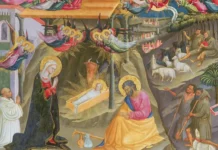“If anyone wishes to come after Me, let him take up his cross and follow Me.” Dr. Plinio saw, in these words of Our Lord, the key to human happiness. Only those who lovingly accept the crosses that God sends them find spiritual peace – a timely topic for this month which commemorates the exaltation of the Cross par excellence, that of Christ.

The exaltation of the Holy Cross of Our Lord Jesus Christ is one of the most beautiful feasts of the Church, both in title and significance.
First of all, let us consider what the word exaltation evokes.
In common usage, pervaded with sentimentalism, an exalted individual is one who is highly excitable, subjecting others to his arrogance. True exaltation, however, has nothing to do with conceit. From the Latin exaltare, it means to raise, to uplift, to ascend.
The exaltation of the Holy Cross of Our Lord Jesus Christ is, therefore, the feast by which the Church recalls and proclaims to the world that it raises the symbol of Redemption above all things, lifting it to its rightful and supreme height.
The apex of humiliations suffered by Jesus
This praise is clothed in even greater majesty and jubilation when we consider that the cross was originally an instrument of torture used throughout Antiquity, representing ignominy and shame for the person who suffered death by crucifixion.
Therefore, in being nailed to the Cross, Our Lord Jesus Christ suffered tremendous humiliation. This is to say that He died like an outlaw, a thief, equated with the two criminals who were crucified with Him on the height of Golgotha.
In this sense, the Cross represents the apex of all the contempt and scorn that Jesus suffered in His public life, especially during the tragic days of the Passion. These humiliations satisfied the desire of the executioners to add an even more painful moral martyrdom to that of the physical torments. Thus, with the crown of thorns, the robe of mockery, the reed simulating a sceptre, the blows, etc., their intent was to torment the adorable Soul of Our Lord, not just His Most Holy Body.
While it is true that the Cross of Our Lord was the apex of all the humiliations He suffered, it was also the beginning of all the contempt that Catholics would have to endure in the name of the Son of God until the end of the world. For impiety never lays down its arms. It always aims to disparage and put down genuine Christian morality. Rare, if not non-existent, are Catholics who have not been humiliated, in one way or another, for their fidelity to Jesus Christ. This constitutes one of the beatitudes, for it means to be persecuted for love of divine justice, against which the impious constantly rise up.
However, it should be noted that the Cross of Christ and the crosses that we carry for Him are also symbols of our honour. This means receiving humiliation with our head held high, taking pride in it – and moreover, with a spirit of defiance. In face of those who insult us, let us proclaim the supreme symbol of our Faith with even greater gusto and jubilation. This is entirely in accord with the idea of exaltation: to manifest the glory of the Cross, with a pride that quells the outrages that the adversaries seek to perpetrate against Christ.
It is fitting to recall that this pride was already demonstrated in the first centuries of Christianity when, on the eve of the Battle of Milvian Bridge, the Emperor Constantine had a vision of the Cross, encircled with the words: “In hoc signo vinces – In this sign you will conquer!” It was an announcement that the Cross was rising in the sky and would remain definitively on the horizon of the world, humiliating the wicked in their turn.
This is the valour lacking in sentimental Catholics. In face of any humiliation, the latter display an indolent and flaccid countenance, and flee. They bring great shame upon the cause they should protect. Our Faith needs to be defended with a combative spirit and, thus, if someone insults the Cross in our presence, we should respond fearlessly and courageously. Not as one who vindicates his own honour, but as one who responds for the infinitely more precious honour of Our Lord Jesus Christ and, in union with His, that of the Blessed Virgin.
Atop towers and crowns
Similarly, the honour of the God-Man is also avenged by the Church. And for this reason, Catholics regard the Cross as a sign of distinction, as a symbol of that which is most sacred and holy. And placing it atop all things was the constant endeavour of Christian Civilization. We see, then, the expressions characteristic of the age of faith: the Cross atop lofty church and cathedral towers; the Cross atop the crowns of kings and emperors, adorning the noblest coats of arms of the families of the first aristocracy, or serving as the insignia for medals of honour. And in order to indicate the great importance of a document, it began with a cross.
In short, in everything that man held as supreme, the Cross of Our Lord Jesus was present, conveying the idea that, among all the marvels worked by Him in this world, the most admirable and adorable was to have suffered and died on that instrument of shame. Conveying, also, the vengeance for this humiliation, a chivalrous and supernatural vengeance – the exaltation of the Holy Cross!
The Cross glorified within us
We find still another teaching in the Cross.
Our Lord Jesus Christ is the Redeemer of humanity. He had to redeem it by accepting death. Thus, He endured the agony in the Garden of Olives and the scourging of the Passion, He walked to Calvary’s peak and allowed Himself to be crucified, so as to fulfil the mission that had brought Him into the world.
From that moment on, the Cross became the affirmation of the sufferings, of the torments and the difficulties that man accepts to fulfil God’s designs for him on earth. Consequently, he confronts all things, following the example of Our Lord, in submission to the superior divine will. This is the lesson that the Cross gives us: to embrace suffering, sacrifice, holocaust, in an act of man’s fidelity to his own vocation.
This fidelity not only signifies a life-long battle for the triumph of the Catholic Faith and the elevation of the Cross of Our Lord Jesus Christ above all things, but also victory in our internal combats. In fact, we are continually waging war within our souls, in which virtues and sins oppose one another. This antagonism results in internal attrition and friction which is, at times, severe. In this fight, we must always look ahead, and always take the bold initiative in defeating sin. In a sense, this battle is the glorification of the Cross of Our Lord Jesus Christ within us.
True joy is in the Cross
This consideration contains an important corollary.
From the beginnings of Christianity, men were baptized in the shadow of the Cross, they were married under its protection, gave it the most honourable places in their homes and, when the final moment of their lives came, they died looking at it. In other words, the Cross marked the entire life of a Catholic. It is one more expression of the fundamental idea that daily life on earth was made for suffering and heroism. And whoever speaks of heroism, speaks of the Cross.
The true joy of life is not found in enjoying pleasures, great or small, or in having plenty to eat and drink, or in any other type of comfort. Genuine satisfaction in life is that sensation of cleanness of soul we have when we look directly at our cross and say “yes” to it. In this way, we act like Our Lord Jesus Christ, who, without waiting for the suffering to come, foresaw it and set out for the place where He would encounter it. He gave Himself up, advancing courageously, because He desired and carried His Cross to the top of the mountain where He would be immolated.
Therefore, let us avoid the illusion of ephemeral and often false joys, which promise us worldly diversions, vanities and temporal success, for they do not constitute the true essence of our life. “Militia est vita hominis super terram – The life of man upon earth is a warfare” (Job 7:1), said the holy Job. As we have stated, the essence of life is a fight within and outside of us, accepting suffering head on and making of it our joy. This is truly the exaltation of the Cross within us.
There is no sincere Catholic who is not an ardent friend of the Cross, and who, confiding in the merciful help of the Blessed Virgin Mary, will not realize and rejoice in knowing that difficulties and sufferings play an essential role in their pilgrimage in this land of exile. It is in knowing and accepting this state of a fighter – against our own defects, as well as against impiety – and uniting ourselves to the infinitely precious merits of the Passion of Our Lord Jesus Christ, that we open for ourselves the gates to eternal happiness.

Let us imitate Her who most loved the Cross
Everything that we have considered constitutes the spirit of the cross, by which we think of all things from a perspective of crucifixion, by which we fight and triumph, for the great fighters of life were those who clothed themselves in this spirit, in this love of the Cross, in this affinity with suffering that characterizes the true son of the Holy Church and follower of Christ.
There is nothing better we can do to acquire this spirit than to implore it of Our Lady, asking Her to grant us the love that She herself had for the Cross of Our Lord Jesus Christ.
We can imagine, without transgressing the teachings of Catholic orthodoxy, that after the turbulent days of the Passion had passed, as had the joys of the Resurrection and glorious departure of Jesus from this world, two great joys remained on this earth for Our Lady: one, the presence of her Divine Son in the Eucharist; the other, meditation on the Cross. What reflections, what cogitations and prayers must the Co-Redemptrix have formulated in her hours of solitude and recollection, recalling the wood upon which the Lamb of God immolated Himself! How She revered that Cross! How She honoured it! And what sublime meditations She must have made at the foot of the Cross, at the very moment in which the Saviour died upon it! And to what elevated and unimaginable degree must the spirit of suffering have been raised within Her – the spirit of the cross – making Her a luminous example for us of a crucified soul!
Therefore, we should ask Mary, in the name of those solitary meditations She made before the Cross – in which perhaps She had each one of us in mind – that same spirit of the cross. May She instill in us that respect, that admiration and that enthusiasm for true suffering and, moreover, that heroic desire to suffer, which is the mark of the true Catholic. In a word, let us beseech of Her the grace of this continual exaltation of the Holy Cross within us, so as to continually exalt it around us. ◊
Taken, with small adaptations,
from “Dr. Plinio” magazine
Year III. N.30 (Sept., 2000); p.16-20






